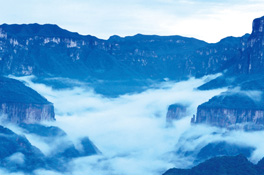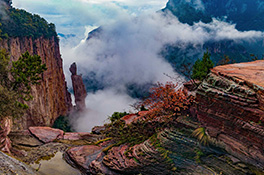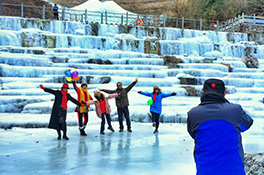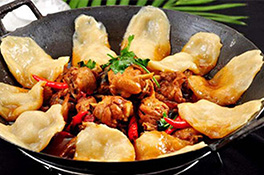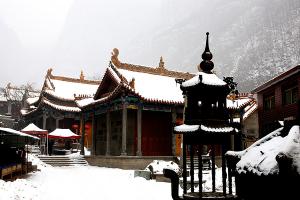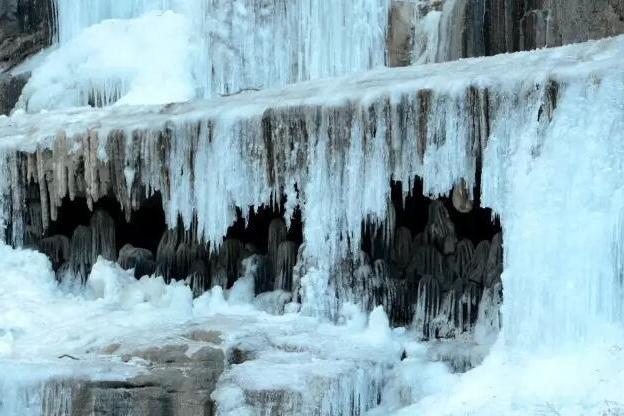
Minor Western Heaven Section
Opening hours:AM8:00—PM6:00
Area:Xilian Scenic spot
Fine line:travelling guideline See the Raiders
Contains attractions:
Tong Hui BridgeXilian TempleXieshan DoorThe Great Buddha’s HallHall for 12 Women DeitiesPrimitive Belief YardTong Hui Bridge: As its name implies, Tong Hui bridge means bridge leading to wisdom. You can walk around to enhance your wisdom.
Here is the noted and widely-popular Xilian temple at the intersection of Henan, Shandong, Shanxi and Hebei. Xilian temple is a classical folksy temple for women. If you are interested, you can count the female deities among statues of all sizes in the palace hall.
Xilian Temple: Founded in East Han Dynasty, Xilian Temple is not large but it contains three wonders. You can stand in the yard and look around. Try to get the difference. The gate of the temple is deflected and is not directed at the front and back hall. It is Xieshan Door or deflected mountain door. Travelers who used to show up in many temples would say that the door to a temple lies in the same axle wire to the palace inside. But it is different here in Xilian Temple. It’s a wonder in Xilian temple.
Xieshan Door: Xishan Door is another wonder in Xilian temple. It got a Goddess of Mercy Pavilion on it. According to rules, we don’t build palace halls above the door. Not many temples would build palace halls above the door. But a Goddess of Mercy Pavilion is built above Xieshan Door. It is also south-to-north inversely-seated Guanyin. It’s another wonder for Xilian Temple.
Xilian Temple is a temple many deities believe in. Buddha, Taoism and Confucianism are all worshiped in the same temple. It is also rarely seen. It indicates that people do not show division in fractions in their worship of deities as long as they can bless them a well-off and prosperous life.
Xilian temple is built above Jiulian terrace. A wonderland of nine ponds holding lotus is formed. XIlian temple consists of three parts namely five-yard palace hall, three palace halls for Hall for the Mother in the western cliff after passing the 200-stair Lian Xin ladder. And the third is Lotus cave at the back of the temple.
The Great Buddha’s Hall: It is the Great Buddha’s Hall to worship Buddha Shakyamuni. When Xilian Temple was first built, they didn’t worship Buddha Shakyamuni. With expansion by Empress Wu Zetian, they began to worship Buddha Shakyamuni. It lasts till today.
Now allow me to introduce you the habit of ‘substitute deities.’ Please look up. It got many clay or wooden figures with their names on the back. They use the figures to guard the deity day in and day out to show their sincerity and request a healthy and safe life and promotion in their career. This habit is ascribed to a habit a long time ago. According to the story passed on by word of mouth, it is originated from East Han Dynasty and is correlated with Liu Xiu. Being chased by Wang Mang’s officers Liu Xiu escaped to Jiulian Temple and confronted dangers repetitively. He was saved by local people or the incarnation of Jiulian Mother. When Liu Xiu became the emperor, he gave a decree in building Xilian temple to worship Jiulian Mother. He built up Lotus Tranquility Palace as a resting place for mountain people who used to save his life. When they were short of food or light, Liu Xiu dispatched Yin Lihua, his wife, to get dressed a commoner and delivered them food and lamp oil. ‘Congregation of Lamp Oil for Jiulina Mother’ took form. Due to his identity, he didn’t show up here often. Yin Lihua could not show up due to her poor physical state. Liu Xiu got someone who looked exactly like him and went up the mountain for him to accompany Jiulian Mother to show his gratitude and sincerity. Yin Lihua also used the method. Citizens then followed suit. As commoners, they could not get real people as their substitutes. Instead, they used clay figurines, wooden or stone figurines as their substitute and wrote down their names at the back to take care of Jiulian Mother on their behalf and ask for blissing. Substitutes to take care of the deities were then placed in all corners of the palace. They are kneeling, standing or showing worship and form a gorgeous scenic line. But it is pity that these substitutes were removed during the turbulent years. This habit is passed down. According to legend, these substitutes got approval from the Jade Emperor and are allowed to meet with their ‘early generation’ or ‘later generation’. Whether they are true or false, they carry rosy aspiration by people. If you are interested, you can get yourself a substitute. You can put your substitute in the palace for female deities if you long for health, safety and harmonious family. You can position it in the palace for Ksitigarbha if you want safety and happiness. If you put it here in the Great Buddha’s Hall or the Palace for Jiulian the Mother, all your wishes will come true.
Hall of Great Mercy: Now here is the Hall of Great Mercy. It worships Thousand-Hand and Thousand-Eye Avalokiteshvara. It is also called Great Mercy Guan Yin. Chinese people’s worship towards Thousand-Hand and Thousand-Eye Avalokiteshvara can trace back to a long time ago. Worship of Thousand-Hand and Thousand-Eye Avalokiteshvara can dispel disasters, enhance a loving heart and subdue the evilness. Arya Avalokiteshvara has many embodiments. 33 of them are worshiped in this hall. Thousand-Hand and Thousand-Eye Avalokiteshvara lies in the middle. We got 31 Guan Yin on the wall both downstairs and upstairs. Thousand-Hand and Thousand-Eye Avalokiteshvara is Miao Shan, third daughter to King Miao Zhuang. Bent on not getting married, Miao Shan cultivated herself and became a Bodhisattva. King Miao Zhuang was irked and drove Miao Shan out of the imperial palace. King Miao Zhuang was then ill and his life was in danger. Miao Shan chopped her hand and scooped her eyes to save her father. On learning that his third daughter saved his life, King Miao Zhuang was grateful and begged God to give Miao Shan one thousand hands and one thousand eyes. Miao Shan then got one thousand hands and one thousand eyes. The God and Buddha in the Hall of Great Mercy fully embody the traditional cultural essence of filial piety and father’s love.
In the Hall of Great Mercy, light in front of Buddha is on offer. It is a faith with a history of over 100 years. Light in front of Buddha embodies wisdom, virtue and brightness. Longevity Light helps bless you a healthy body and a long life. Wisdom light helps you get wisdom and academic accomplishment. Safety light guarantees you a safe journey and a prosperous family. Fortune Light helps you great wealth and accomplished dreams. Legend goes that light in front of the Buddha here works wonders. You can try one.
Hall for 12 Women Deities: Here is the Hall of 12 Women. It worships 12 female deities. They are in charge of all kinds of affairs covering women, children, wedding and family. It should be noted that in the wide swath of areas in Henan, Shandong, Hebei and Shanxi, they would have temples worshipping 12 women deities. Their origin and posts can’t be traced in the theogony of China. but joss sticks are intense in here. According to relevant research for now, worship to the 12 women deities were originated from Xilian Temple. Xilian Temple preceded others in worshipping the 12 female deities in a hall. Other places then follow suit by building the Hall for 12 Women Deities.
Who are the 12 women? Different temples would worship different deities. In Xilian Temple, they worship West Sky Mother with Guan Yin Mother in the back, Quiet Mother, Mountain Tai Mother, Sibling-delivery Mother, Golden Mother and Mountain Mother on the left, and Mountain-blazing Mother, Sky-holding Mother, Wen Shu Mother, Virtue Mother and Ksitigarbha Mother on the right.
Disciples hold the 12 mothers with high esteem. A ballad in Mountain Jiulian fully reflects their worship.
The round soybean can be ground into bean curd that looks like white lotus.
The bean curb can be fried to the shape of lotus in a pan.
People adore lotus and pay tribute to the statue of female deities with white lotus.
The 12 mothers are satisfied and would guarantee you a wholesome year.
That the 12 female deities gather around in one room to dispel diseases and guarantee luck and prosperity is rarely seen in other temples. Another interesting story goes on in this temple. Everybody, please look at the mural on the wall in the west. It’s a story on ‘saving of Bao Gong by 12 mothers’. The story in this mural is still unique till today. According to legend, Bao Gong came over to Bao Gong Village in Huixian City to dig into a murder case by influential people. The murderer was a rich man in the local place. His three sons are all officers in the capital city with connection to the royal family. The murderer didn’t take Bao seriously and put him into jail with an attempt to kill him. On learning that, the 12 mothers in Xilian Temple worked with concerted efforts and saved him. After unshackling the case, Bao Gong killed the murderer. People then drew the mural on ‘saving of Bao Gong by 12 mothers’ to honor the story.
Primitive Belief Yard: The primitive belief yard lies in the front. To satisfy people’s religious demands, Jiulian Mountain Scenic Spot renovates the traditional habits of religious belief in Xilian Temple and builds the primitive belief yard. San Qing Taoist Temple and Founder’s Palace in Southern Roof lie in here. All religious behaviors by incense burners in the palace and yard are not purposefully arranged.
Many people would use one or two or three pens to scribble on paper. They call it heaven scripture. Painters would call themselves as to ‘write down account’ or ‘draw groundwork’. It is called Fu Zhuan in Taoism. People engaged in it are quite loyal and assiduous. They would do it throughout the day before delivering them to the deity through burning. The contents remain secret to the outsiders, for it is predestined. Specialists are digging into that content. But it is not known to common people.
According to local legend, acceptance with hiccup, chanting scripture or crying in front of the deity all falls to folksy faith. You can get to learn faith and culture passed down through generations and get to ruminate over their faith. Friends who show interests in these unique faiths can come here often and dig them out.
Immortal-cross Bridge: The nondescript bridge has an astounding name. It is called Immortal-cross Bridge. The old bridge was made of stones with branches serving as the bridge. To facilitate travelers, this bridge was built up. It still used the original name. The scene in the gorge is magnificent with waterfalls connecting to one another. Legend goes that female deities in Xilian temple often pass through the bridge and get dressed in water in the gorge. So this bridge is called Immortal-cross Bridge.
Immortal Rouge Peak: This gorge is called Immortal Rouge Peak. Legend goes that the Queen Mother of the West and Jiulian Mother used to get dressed and wear makeup in here. But they knocked over the rouge box by accident and the powder got sprayed in the gorge. The gorge then showed chromatic colors. It looks stunning. People then call it Immortal Rouge Peak.
After passing the Wisdom Bridge, please look up and have a look. How many peaks are there? Nine, right? The nine peaks are clustered and are likened to a blooming lotus flower. That’s the origin of Jiulian mountain or nine-lotus mountain.
Water Droplet Cliff: As its name implies, it is droplets in cliffs. The mountain rocks are red with their rich content of iron. You can hear the babbling sound of water from afar. You can catch sight of a swath of silver water by walking through the stone pavement. Then here we are at the Mirror Pond. Legend goes that Jiulian Mother and female deities used to get dressed up in here. Water in the pond is crystal with reflections of trees by the mountain being distinct to see. It looks like a huge mirror in the immortal world. Come over and look at your reflections in water. I bet you will see your fairytale-like posture.
Tian Yun Pond: Here we are in Tian Yun Pond. The waterfall on the east is called Phoenix Waterfall. Dragon Waterfall lies in the north. It is the most characteristic view in Jiulian Mountain. Pool in the Phoenix Waterfall to the east of the rock is also called Hand-washing Pond. Pool under the Dragon Waterfall is called Feet-washing Pool. According to legend, two sisters-in-laws could not get pregnant after getting married for years. The elder sister-in-law accidentally washed her hand in the pool in the east and gave birth to a daughter. The younger sister-in-law washed her feet in the pond in the north and gave birth to a son. Many people would then come over here to wash their hands in the hope of having a daughter or wash their feet in the hope of having a son. The two ponds get their names in this way. It fully implies that commoners have the habit of lavishing their rosy aspiration on landscape.
Yan Shui Wall: Here is Yan Shui Wall. Water in the mountain is seeping to the underground. During dry seasons, it has extenuated current. But in flood season, it has big current. Water gets a state to demonstrate itself in here. in winter, the frozen silver thaw can manifest magnificent beautiful scenes. A Chinese yew lies in Yan Shui Wall. You can look for it if you know it. Chinese yew is the First-grade protection tree of the nation. As its fruits are likened to lovesickness beans in the Southern Kingdom, it is called Chinese yew or lovesickness tree. Chinese yew has been living in the planet for over 2.5 million years. It is honored as ‘geomantic tree’ and is quite precious. Anti-cancer drug widely acknowledged in the international society can be extracted. It can induce diuresis, reduce edema and cure kidney disease and diabetes.
Dragon Playing with Water: It is a place with miraculous mountain ranges, verdant trees, crystal clear pond water and mesmerizing precipices. The magnificent scenery here is likened to a bonsai in the garden of the southern Yangtze Delta. The stalactite that hangs upside down and is formed with erosion of water is akin to dragon head poking its head to water. Two brooks are flowing to the azure pond. They bear semblance to dragons playing with water.
Ancient Aisle: Here we are in a platform with river degradation of ancient aisle. A tunnel lies under the precipitous precipice. It is around 150 meters in length and the traces left over in the palisades are likened to aisles made by ancient man. By taking a stroll in this old long aisle and wandering in the plank road at the precipice, people can appreciate the red cliff, the azure sky and blue water. They can also appreciate the natural geological landscape formed by such quartz.
Inside Corner: After walking down the old aisle, we can come over to ‘Inside Corner’. Inside Corner has three ways. It leads to the primitive forest. Another leads to Rebirth Road and Lotus cave. The Rebirth Road used to be a small track with primitive ecology in the cliff. The track is oftentimes blocked by weeds and bushes. It’s quite adventurous to walk by. Interlinked elms by the road are like Bonsai. In the past, mountain people thought that the Rebirth Road was an impasse. Only the herding goats can pass by. People dared not to walk by. The Rebirth Road is paved with roads and leads all the way to Lotus Cave. It’s no longer dangerous walking past it. Covered by trees, the road is shady and would perk people up.
Three-general Hall: Three-general Hall is a sure way leading to Lotus Cave. According to legend, Mu Guiying, a woman general of the Yang Family, was on a mission against soldiers of Liao Dynasty. The two parties came to a showdown in Hongzhou of Huixian City. In order to disperse soldiers of Liao and use the few to defeat the many, Mu Guiying dispatched three generals and enticed them away by tying up a broom to the ponytail and stirring up dust to the west. Liao soldiers dispatched a squad to chase them. They soon discovered that they were cheated. Furious, they swear to capture the three generals alive. At the peak of Jiulian Mountain, the three generals jumped downwards from the cliff. Local commoners discovered their dead bodies and prayed that Jiulian Mother would bless them in their afterlife. Jiulian Mother changed a stone to a coffin and put the three generals inside. It shows exuberant incense. Incense burners in Lotus Cave have t burn joss sticks and pay tributes. It reflects their respect and reminiscence of the generals of the Yang Family.
Palace for Jiulian Mother: Jiulian Mother, the main Goddess in Minor Western Heaven of Jiulian Mountain, is worshiped in Palace for Jiulian Mother. It used to be a small cave and the place where Jiulian Mother cultivated herself. The Palace now was renovated to satisfy wish by incense burners. The palace represents the highest level for architectural art in Xilian Temple. The colored drawing at the gateway was independently drawn by provincial-level master for folksy art. The statute of Jiulian Mother worshiped in the Palace is the No. One wooden sculpture in Xilian Temple. It was engraved by a world-class engraver for folksy handicraft approved by the UNESCO. The statute is 1.99 meters in height and 1.69 meters in width. It is dignified, genial and lifelike with fine features. It is a valuable artwork,
Ling Jian Stone: Everybody, please look to the front. A strip stone that seems to get away from the mountain is what we call Ling Jian Stone. According to legend, Mu Guiying used to drill her army in here. Ling Jian Stone is turned by the arrow when Mu Guiying called the muster roll of officers and assigned them tasks. That disciples worshiped Mu in here shows their tributes to the hero of Yang Family.
Lotus Cave: Lotus Cave is also called Water Curtain Cave that sees incessant gushing on the yearly basis. It is connected to water at the deepest. It is over one meters in depth. The exact depth of the cave and water still calls for investigation by professionals. The cave is cool in summer with breeze to the entrance. It is so refreshing. It is said that water in the Lotus Cave is high-qualified and curative.
Waterfall Cluster Ditch: Waterfalls in Waterfall Cluster Ditch are interlinked and overlapped. When looking downward, waterfalls are gushing downwards. When looking upwards, waterfalls constitute a magnificent picture of landscape.
You can walk around and have a look at it. Travelers who fancy water can climb up a riverfront rock and feel its water. You can either drink it or play with it. You can enjoy its joy to the full. Let me warn you again. Take care.
Hou Jing Palace: Here we are in Hou Jing Palace. You can check the virtue tablet by the road. It records donations to restore Houjing Palace. It was built in East Han Dynasty. According to legend, Liu Xiu didn’t get anything to eat or drink for two days in order to avoid being hunted down by Wang Mang. He came over to this place and fell down to the ground due to starvation. He was brought back to life s a hoary lady fed him with her own meal. Despite her poverty, the old lady who took inhabitant in the cave saved him. Liu Xiu was grateful. Liu Xiu then built a place in here and named it Hou Jing Palace so that the old lady could live an easy life in old age. After the old lady died, local residents built a temple and named the place Hou Jing Temple. Legend goes that Liu Xiu came over here for the vegetable rice made by the old lady. The vegetable rice is passed down till today. Local people call it ‘Liu Xiu vegetable rice’. When Emperor Shunzhi in Qing Dynasty became a monk, he used to present this place. Staved, Emperor Shunzhi was saved as an old lady cooked him Liu Xiu vegetable rice. Emperor Shunzhi wrote an inscription for Houjing Palace:‘Though hard to be seen, it reponds to the one who prays for it. Though hard to be heard, it responds to the one who hugs it’.
A ballad in Jiulian Mountain goes:
The delicacy of vegetable rice is a pot of soup with wild grass and turnip.
Liu Xiu became an emperor after taking it and citizens would get their starvation dispelled.
‘Liu Xiu vegetable rice’ has become a featured delicacy in Jiulian Mountain. You can try it later.
Houjing Palace has four yards that are renovated in recent years. The original temple is large in scale. In a battle against ‘imperial harem’ in order to contend for fung shui, all temples were wrecked. Lingchuan in Shanxi suffers drought for three consecutive years and many people were staved to death. Li Hengwen, leader of Gun Chamber in Lingchuan invited people to check on Fung Shui. Masters of Fung Shui all reckoned that the mountain for Hou Jing Palace was an aggregating place for dragon vein that was clustered in the spring water of Hou Jing Palace. As spring water was flowing incessantly to Henan, Shanxi was drained of water. Li Hengwen then proposed that ‘cloud would foretell wind and dismantling of temples would lead to raindrops’. He took thousands of people and seize the area before forcibly occupying Houjing Palace and dismantling all the temples. But he could not hinder the spring water in the mountain and could not relocate it to Shanxi.
People and incense burners at the hill of Jiulian Mountain delegated Xing Rulou to go to court with Shanxi. After three years, they won back Hou Jing Palace.
Stone Elm Slope: This swatch of forest is what local people call ‘stone elm slope’. As elm trees in here are aged and wood is as rigid as stone. It thus gets the name.
Dragon Out of Shell: You will first catch sight of Dragon Out of Shell in here. It takes form as running water constantly washes against the natural stalactite. The green precipices are swiped to bizarre shapes by water. It is said that when rainy seasons befalls, mountain spring water will be gushed out that is likened to dragon out of shell and sends out astounding sound. It is called ‘Ringing Spring’. You can see temples in Taihe Terrace. It can be taken as ‘blessing tree’ in front of the temple. Travelers can go over to the Logistics Office and ask for an ‘note for bliss’. Put down your wish in the ‘note for bliss’ and tie it to the thousand-year-old pine. With the old pine as witness, your fortune and prosperity will be guaranteed. Travelers who donate charitable money to the Charity Box in the Third Emperor’s Palace can be given a ‘consecrated amulet’. It can forebode well-being and safety. Travelers who donate charitable money can be presented a pair of ‘plate of luck’. You can put down your wishes in one of them and hang it in the palace while taking the other ‘plate of luck’ back home.
Rock Patch: The mountain road at one side of the cliff can lead to Shanxi. By walking downwards along the mountain, travelers can access Sky Door after passing Rock Patch. Rock patch is littered with red rocks. According to legend, Goddess Nv Wa tempered 36500 colorful stones with fire for repairing the broken sky. These are gravels left over after Goddess Nv Wa amended the sky.
Sky Door: It lies right in front of Hou Jing Palace. This is the imposing Sky Door. The two precipitous mountains are way apart. When looked from afar, the two mountains are akin to a door. It thus gets its name as ‘Sky Door’.
- tips
- Security
-
1. do a good job of personal protection: do the appropriate clothing shoes, hats, do a good job of prevention, anti-mosquito work.
2. pay attention to personal safety: Please in the scope of their own risk control activities, pay attention to personal safety, emergency situations during the journey, should immediately call the police and seek the help of local police agencies
3. Prevent water risks: When cruising on water or activities, you should pay more attention to safety. You must not go into the water or go to deep water areas or dangerous water areas. You should follow the instructions and the dynamics of the table.
- Article storage
-
1. Keep valuables safe: Don't place valuables on checked baggage, hotel rooms, or tour buses. Keep your belongings in safe place. Do not open your sight line, or visit and photograph, walk, or shop. Beware of stolen.
2. Carrying a travel ticket: Personal identification documents, travel documents, and transportation tickets should be kept with you to avoid forgetting or losing.
- Pay attention to hygiene
-
pay attention to food hygiene: to increase protection of infectious diseases, epidemic awareness. Pay attention to food hygiene, do not eat unsanitary, unqualified food and drinks, do not litter in the area, pay attention to environmental hygiene.

